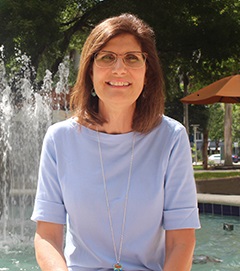Alternatives to Opioids: There is a Better Way

Tormented by chronic back pain? Bummed by a long-ago shoulder injury? Is your rheumatoid arthritis unbearable?
If you suffer from such conditions and visit your primary care doctor for relief, you’re likely to get a prescription for a pain killer. And that pain killer may be an opioid, such as oxycodone or hydrocodone. It’s the go-to treatment used by physicians for pain. In fact, Americans get more opioid prescriptions than any other country in the world, a reason why the nation is undergoing a widespread opioid crisis.
Yet while opioids, prescribed correctly, can be effective for acute pain, there is no evidence that they work for long-term pain.
“Many physicians simply aren’t aware that there are better options for treatment,” says Dr. Dennis Patin, an anesthesiologist and pain medicine specialist at the University of Miami Health System. “At the same time our focus is on pills. Patients come into a doctor’s office wanting something immediate. They want to walk out of there with a prescription.”
It’s estimated that about 100 million Americans are living with some form of chronic pain, whether it’s from a traumatic injury or a medical condition such as fibromyalgia or osteoarthritis.
In some cases, there may not even be an obvious physical explanation. Scientists says that some people may be more susceptible to acute pain turning into chronic pain because of genetics. What’s more, pain is subjective and when patients are asked to report on the intensity, they tend to report on the higher part of the scale.
Regardless of the underlying reason, long term pain, with its distinct pathology, can be both physically and psychologically devastating. It even changes the nervous system, ultimately making the horrible debilitating feeling even worse. This, Dr. Patin adds, is one of the reasons why pain should be considered as a separate disease unto itself and its treatment and management as its own medical discipline.
Changing the way the medical community treats pain, however, can be difficult.
“Pain is more complicated than cancer, but we’re in pain treatment where we were with cancer 100 years ago,” he says.
Confounding treatment options is the fact that we don’t completely understand the many facets of chronic pain. Researchers posit that there are multiple pathways that lead to pain and so far it has been impossible to identify which individual pathway may be responsible for a person’s hurt.
For decades, opioids were considered a good treatment option and rather harmless.
A 1980 letter to the editor from a physician in the New England Journal of Medicine concluded that the possibility of narcotic addiction in hospitalized medical patients was almost nil, with only four documented cases among almost 12,000 patients who had no history of addiction.
Now, however, we know that opioids are highly addictive — enough for dependency to kick in within a few days — and they can suppress a patient’s ability to breathe. Because tolerance builds up quickly, patients have been known to turn to other illicit drugs for a fix. More than 500,000 deaths were blamed on opioid use between 2000 and 2015, according to the CDC. And in 2016 drug overdoses killed 63,632 Americans, with nearly two-thirds of these deaths involving a prescription or illicit opioid. It is estimated that the national opioid crisis claims 175 lives a day nationally and 15 lives a day in Florida.
A recent study published in JAMA Network Open found that it’s young adults who have been the hardest hit by the epidemic, with 20 percent of the age group involved with opioids. In 2001 that was only four percent.
There are many factors affecting the opioid scourge.
These include lack of training among doctors, a lack of assessment tools and prescription drug monitoring databases, as well as heavy promotion of the drugs by the pharmaceutical industry. To counter the alarming trend politicians and health care providers have been working to stem the wave of opioid misuse.
In 2016 the CDC released its recommendations, directing doctors to try nondrug treatment and non-opioid treatments first before adding opioids. That same year the U.S. Department of Health and Human Services also issued a “National Pain Strategy” that dovetails with the CDC recommendations, calling for treatments that include alternative therapies as well as treatment that takes into account the mental and social concerns of a pain sufferer. These efforts, Dr. Patin says, have helped lead to a 20 percent reduction of opioid production, with another 25 percent reduction expected this year.
A public health emergency
On the legal front, last fall President Donald Trump declared a public health emergency, ordering federal agencies to allocate additional funds to combat addiction — more than 2.5 million Americans abuse prescription opioids or heroin, according to the American Society of Addiction Medicine — and Florida Governor Rick Scott earlier this year signed a law that curtails opioid prescriptions to a 3 or 7-day limit, exempting patients with cancer, terminal illness, in palliative care or suffering from a trauma with severity of 9 or above. In May six states, including Florida, sued an opioid maker alleging deceptive marketing of its drugs. Other cities and counties have filed similar suits.
These measures alone won’t solve the problem, however.
Since “drugs tend to fall into the wrong hands, whether they’re borrowed or sold or stolen, and humans have been known to look for drug-induced adventure,” Dr. Patin points out.
Nevertheless, he and his colleagues are on a mission to educate both fellow physicians and the public about alternatives to opioids to treat chronic pain.
We’re moving away from pain scores to functionality. What can patients not do, what do they want to do and how can we get them where they want to be.
Dr. Patin
To achieve this, Dr. Patin works on various levels. For chronic pain, Dr. Patin recommends visiting a pain specialist who will prescribe interdisciplinary treatments to deal with pain’s diverse effects on the body and mind.
“For many, seeing a legitimate pain management specialist who actually recognizes that the pain is not in their heads can be a relief,” Dr. Patin says. “Finally, somebody has listened to them, somebody has given them hope.”
Most of the time he doesn’t prescribe medications, though non-opioid analgesics are a good option.
“I offer procedures and interventions.”
When he describes medications, he favors acetaminophen (Tylenol), nonsteroidal anti-inflammatory drugs (NSAIDs, such as Advil, Aleve and Motrin) and muscle relaxants.
He’s not against prescribing opioids, but only under very strict conditions: for acute pain, for a limited time, with the knowledge by the patient that these will be discontinued, and when alternatives have been considered first.
“A chronic, continuous condition isn’t going to respond in the long term to short-term treatment.”
Dr. Patin also uses exercise, acupuncture, physical therapy and other physical modalities (such as nerve stimulation, moist heat, cold and light therapy) as well as TENS devices (transcutaneous electrical nerve stimulation). In addition, he suggests a combination of primary disease management and cognitive-behavioral therapy (CBT).
Modern pain management should address all these elements with an “integrated approach.”
“The idea is to ensure that these [treatments] are integrated and not done in isolation,” he says.

In Their Words
Ana Veciana-Suarez, Guest Contributor
Ana is a regular contributor to the University of Miami Health System. She is a renowned journalist and author, who has worked at The Miami Herald, The Miami News and The Palm Beach Post. Visit her website at anavecianasuarez.com or follow @AnaVeciana on Twitter.
Tags: Dr. Dennis Patin, opiods, pain management, public health
